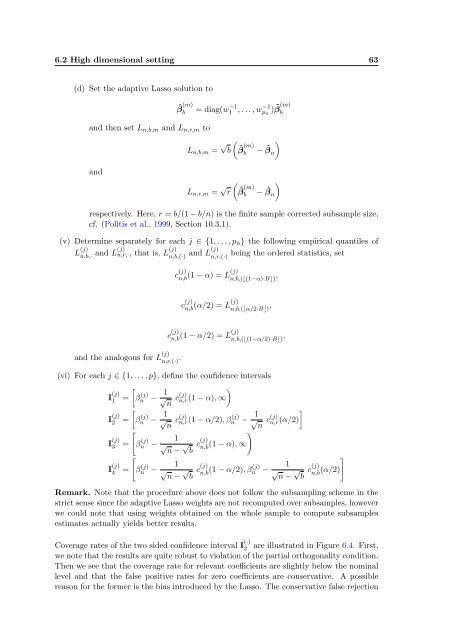Subsampling estimates of the Lasso distribution.
Subsampling estimates of the Lasso distribution.
Subsampling estimates of the Lasso distribution.
Create successful ePaper yourself
Turn your PDF publications into a flip-book with our unique Google optimized e-Paper software.
6.2 High dimensional setting 63<br />
(d) Set <strong>the</strong> adaptive <strong>Lasso</strong> solution to<br />
ˆβ (m)<br />
b<br />
and <strong>the</strong>n set L n,b,m and L n,r,m to<br />
= diag(w1 −1 , . . . , w−1 p n<br />
) ˜β (m)<br />
b<br />
L n,b,m = √ ( )<br />
b ˆβ (m)<br />
b − ˆβ n<br />
and<br />
L n,r,m = √ ( )<br />
r ˆβ (m)<br />
b − ˆβ n<br />
respectively. Here, r = b/(1 − b/n) is <strong>the</strong> finite sample corrected subsample size,<br />
cf. (Politis et al., 1999, Section 10.3.1).<br />
(v) Determine separately for each j ∈ {1, . . . , p n } <strong>the</strong> following empirical quantiles <strong>of</strong><br />
L (j)<br />
n,b,· and L(j) n,r,·, that is, L (j)<br />
n,b,(·)<br />
and L(j)<br />
n,r,(·)<br />
being <strong>the</strong> ordered statistics, set<br />
c (j)<br />
n,b<br />
(1 − α) = L(j)<br />
n,b,(⌊(1−α)·B⌋) ,<br />
c (j)<br />
n,b<br />
(α/2) = L(j)<br />
n,b,(⌊α/2·B⌋) ,<br />
and <strong>the</strong> analogous for L (j)<br />
n,r,(·) .<br />
c (j)<br />
n,b<br />
(1 − α/2) = L(j)<br />
n,b,(⌊(1−α/2)·B⌋) .<br />
(vi) For each j ∈ {1, . . . , p}, define <strong>the</strong> confidence intervals<br />
[<br />
I (j)<br />
1 =<br />
[<br />
I (j)<br />
2 =<br />
[<br />
I (j)<br />
3 =<br />
n − √ 1 c (j)<br />
n<br />
β (j)<br />
β (j)<br />
)<br />
n,r(1 − α), ∞<br />
n − √ 1 c (j)<br />
n<br />
n,r(1 − α/2), β n (j) − √ 1 c (j)<br />
n<br />
β (j)<br />
n<br />
−<br />
[<br />
I (j)<br />
4 = β n<br />
(j) −<br />
1<br />
√ n −<br />
√<br />
b<br />
c (j)<br />
n,b (1 − α), ∞ )<br />
1<br />
√ √ c (j) (1 − α/2), β(j) −<br />
n − b<br />
n,b<br />
n<br />
]<br />
n,r(α/2)<br />
1<br />
√ n −<br />
√<br />
b<br />
c (j)<br />
n,b (α/2) ]<br />
Remark. Note that <strong>the</strong> procedure above does not follow <strong>the</strong> subsampling scheme in <strong>the</strong><br />
strict sense since <strong>the</strong> adaptive <strong>Lasso</strong> weights are not recomputed over subsamples, however<br />
we could note that using weights obtained on <strong>the</strong> whole sample to compute subsamples<br />
<strong>estimates</strong> actually yields better results.<br />
Coverage rates <strong>of</strong> <strong>the</strong> two sided confidence interval I (·)<br />
2 are illustrated in Figure 6.4. First,<br />
we note that <strong>the</strong> results are quite robust to violation <strong>of</strong> <strong>the</strong> partial orthogonality condition.<br />
Then we see that <strong>the</strong> coverage rate for relevant coefficients are slightly below <strong>the</strong> nominal<br />
level and that <strong>the</strong> false positive rates for zero coefficients are conservative. A possible<br />
reason for <strong>the</strong> former is <strong>the</strong> bias introduced by <strong>the</strong> <strong>Lasso</strong>. The conservative false rejection
















